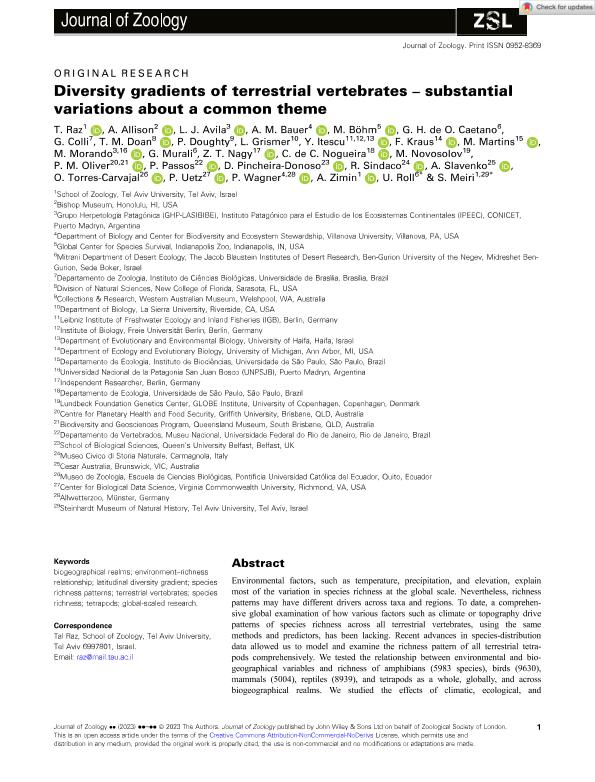Artículo
Diversity gradients of terrestrial vertebrates – substantial variations about a common theme
Raz, T.; Allison, A.; Avila, Luciano Javier ; Bauer, A.M.; Böhm, M.; Caetano, G. H. de O.; Colli, G.; Doan, T.M.; Doughty, P.; Grismer, L.; Itescu, Y.; Kraus, F.; Martins, M.; Morando, Mariana
; Bauer, A.M.; Böhm, M.; Caetano, G. H. de O.; Colli, G.; Doan, T.M.; Doughty, P.; Grismer, L.; Itescu, Y.; Kraus, F.; Martins, M.; Morando, Mariana ; Murali, G.; Nagy, Z.T.; Nogueira, C. de C.; Novosolov, M.; Oliver, P.M.; Passos, Paulo; Pincheira Donoso, D.; Sindaco, R.; Slavenko, A.; Torres Carvajal, O.; Uetz, P.; Wagner, P.; Zimin, A.; Roll, U.; Meiri, S.
; Murali, G.; Nagy, Z.T.; Nogueira, C. de C.; Novosolov, M.; Oliver, P.M.; Passos, Paulo; Pincheira Donoso, D.; Sindaco, R.; Slavenko, A.; Torres Carvajal, O.; Uetz, P.; Wagner, P.; Zimin, A.; Roll, U.; Meiri, S.
 ; Bauer, A.M.; Böhm, M.; Caetano, G. H. de O.; Colli, G.; Doan, T.M.; Doughty, P.; Grismer, L.; Itescu, Y.; Kraus, F.; Martins, M.; Morando, Mariana
; Bauer, A.M.; Böhm, M.; Caetano, G. H. de O.; Colli, G.; Doan, T.M.; Doughty, P.; Grismer, L.; Itescu, Y.; Kraus, F.; Martins, M.; Morando, Mariana ; Murali, G.; Nagy, Z.T.; Nogueira, C. de C.; Novosolov, M.; Oliver, P.M.; Passos, Paulo; Pincheira Donoso, D.; Sindaco, R.; Slavenko, A.; Torres Carvajal, O.; Uetz, P.; Wagner, P.; Zimin, A.; Roll, U.; Meiri, S.
; Murali, G.; Nagy, Z.T.; Nogueira, C. de C.; Novosolov, M.; Oliver, P.M.; Passos, Paulo; Pincheira Donoso, D.; Sindaco, R.; Slavenko, A.; Torres Carvajal, O.; Uetz, P.; Wagner, P.; Zimin, A.; Roll, U.; Meiri, S.
Fecha de publicación:
11/2023
Editorial:
Wiley Blackwell Publishing, Inc
Revista:
Journal of Zoology
ISSN:
0952-8369
e-ISSN:
1469-7998
Idioma:
Inglés
Tipo de recurso:
Artículo publicado
Clasificación temática:
Resumen
Environmental factors, such as temperature, precipitation, and elevation, explain most of the variation in species richness at the global scale. Nevertheless, richness patterns may have different drivers across taxa and regions. To date, a comprehensive global examination of how various factors such as climate or topography drive patterns of species richness across all terrestrial vertebrates, using the same methods and predictors, has been lacking. Recent advances in species-distribution data allowed us to model and examine the richness pattern of all terrestrial tetrapods comprehensively. We tested the relationship between environmental and biogeographical variables and richness of amphibians (5983 species), birds (9630), mammals (5004), reptiles (8939), and tetrapods as a whole, globally, and across biogeographical realms. We studied the effects of climatic, ecological, and biogeographic drivers using generalized additive models. Richness patterns and their environmental associations varied among taxa and realms. Overall precipitation was the predominant richness predictor. However, temperature was more important in realms where both cold and warm conditions exist. In the Indomalayan realm, elevational range was very important. Richness patterns of mammals, birds, and amphibians were strongly related to precipitation whereas reptile richness was mostly associated with temperature. Our results support the universal importance of precipitation but also suggest that future global-scaled research should incorporate other relevant variables other than climate, such as elevational range, to gain a better understanding of the richness–environment relationship. By doing so, we can further advance our knowledge of the complex relationships between biodiversity and the environment.
Archivos asociados
Licencia
Identificadores
Colecciones
Articulos(IPEEC)
Articulos de INSTITUTO PATAGONICO PARA EL ESTUDIO DE LOS ECOSISTEMAS CONTINENTALES
Articulos de INSTITUTO PATAGONICO PARA EL ESTUDIO DE LOS ECOSISTEMAS CONTINENTALES
Citación
Raz, T.; Allison, A.; Avila, Luciano Javier; Bauer, A.M.; Böhm, M.; et al.; Diversity gradients of terrestrial vertebrates – substantial variations about a common theme; Wiley Blackwell Publishing, Inc; Journal of Zoology; 322; 2; 11-2023; 1-15
Compartir
Altmétricas



